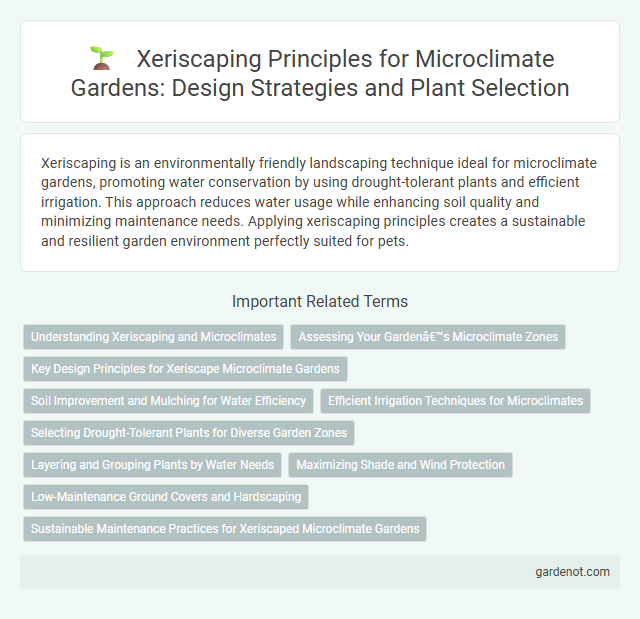Xeriscaping is an environmentally friendly landscaping technique ideal for microclimate gardens, promoting water conservation by using drought-tolerant plants and efficient irrigation. This approach reduces water usage while enhancing soil quality and minimizing maintenance needs. Applying xeriscaping principles creates a sustainable and resilient garden environment perfectly suited for pets.
Understanding Xeriscaping and Microclimates
Xeriscaping integrates drought-tolerant plants and efficient irrigation techniques tailored to specific microclimates, optimizing water conservation in garden design. Understanding microclimates involves analyzing localized temperature, sunlight, and moisture variations to select plants that thrive with minimal water input. Implementing xeriscaping in microclimate gardens enhances sustainability while preserving aesthetic appeal and ecological balance.
Assessing Your Garden’s Microclimate Zones
Assessing your garden's microclimate zones involves analyzing sunlight exposure, soil moisture, wind patterns, and temperature variations to determine the best locations for xeriscaping plants. Mapping these microclimate factors allows for strategic placement of drought-tolerant species, optimizing water efficiency and plant health. Accurate evaluation improves irrigation planning and enhances the sustainability of xeriscaped gardens.
Key Design Principles for Xeriscape Microclimate Gardens
Xeriscape microclimate gardens emphasize water conservation through strategic plant selection, favoring drought-tolerant native species to thrive in localized environmental conditions. Soil improvement techniques such as mulching and organic amendments enhance moisture retention and reduce evaporation in microclimates characterized by extreme temperature fluctuations. Proper irrigation planning, including drip systems and rainwater harvesting, maximizes efficiency while adapting to the specific solar exposure and wind patterns inherent to microclimate zones.
Soil Improvement and Mulching for Water Efficiency
Xeriscaping enhances water efficiency by prioritizing soil improvement through organic matter incorporation, which boosts moisture retention and nutrient availability. Mulching with materials like wood chips or gravel reduces evaporation, maintains soil temperature, and suppresses weed growth, further conserving water. These practices create a resilient microclimate garden optimized for drought tolerance and sustainable landscaping.
Efficient Irrigation Techniques for Microclimates
Xeriscaping in microclimate gardens emphasizes efficient irrigation techniques such as drip irrigation and soaker hoses, which deliver water directly to plant roots, minimizing evaporation and runoff. Utilizing soil moisture sensors and smart irrigation controllers further optimizes water use by adapting watering schedules to real-time environmental conditions. These strategies significantly reduce water consumption while maintaining optimal plant health in diverse microclimate zones.
Selecting Drought-Tolerant Plants for Diverse Garden Zones
Selecting drought-tolerant plants for diverse garden zones enhances water efficiency and supports sustainable landscaping within a microclimate garden. Species such as lavender, agave, and sedum thrive in arid conditions while providing aesthetic variety and resilience. Incorporating native xerophytes adapted to specific microclimates reduces irrigation needs and promotes ecosystem balance.
Layering and Grouping Plants by Water Needs
Xeriscaping enhances microclimate garden efficiency by layering plants with varying water requirements, maximizing moisture retention and minimizing irrigation. Grouping drought-tolerant species together creates zones that optimize water use, reducing waste and promoting sustainable landscaping. Strategic plant placement based on water needs fosters resilient ecosystems and conserves resources in arid environments.
Maximizing Shade and Wind Protection
Xeriscaping techniques for microclimate gardens emphasize maximizing shade and wind protection by using drought-tolerant trees and shrubs strategically placed to reduce solar radiation and wind exposure. Incorporating native evergreens and deciduous plants creates layered vegetation that moderates temperature extremes and conserves soil moisture. Mulching under these plants further enhances water retention and supports a resilient, low-maintenance garden ecosystem.
Low-Maintenance Ground Covers and Hardscaping
Xeriscaping emphasizes drought-tolerant, low-maintenance ground covers such as creeping thyme, sedum, and native grasses that minimize water usage while reducing weed growth. Hardscaping elements like permeable pavers, mulch, and gravel paths improve soil moisture retention and prevent erosion, creating a sustainable microclimate garden. Integrating these features optimizes water efficiency and enhances landscape durability in arid environments.
Sustainable Maintenance Practices for Xeriscaped Microclimate Gardens
Sustainable maintenance practices for xeriscaped microclimate gardens include efficient watering techniques such as drip irrigation and rainwater harvesting to reduce water consumption. Selecting native, drought-tolerant plants minimizes irrigation needs and supports local biodiversity. Regular mulching and soil health monitoring enhance moisture retention and nutrient availability, promoting a resilient microclimate garden ecosystem.
Xeriscaping Infographic

 gardenot.com
gardenot.com